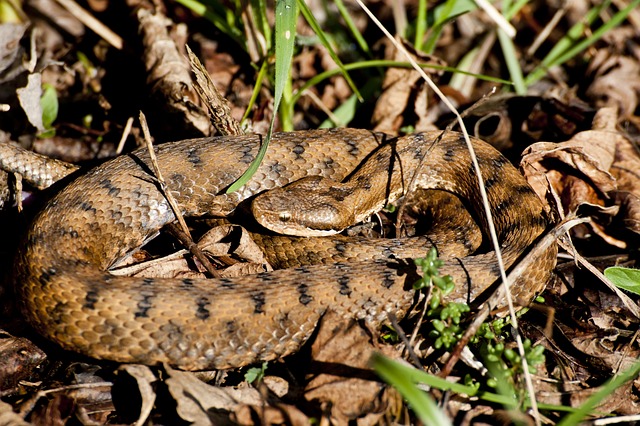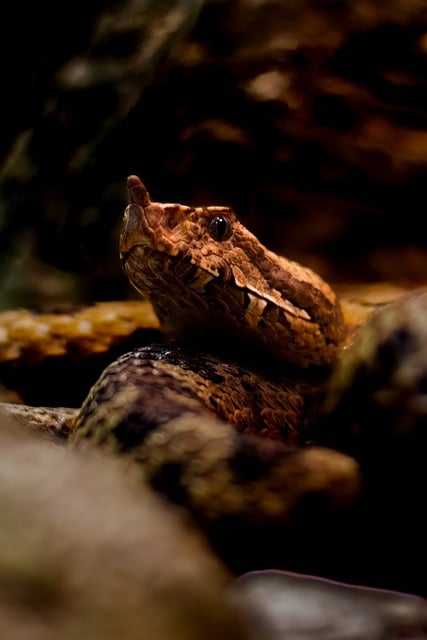Vipers are a group of venomous snakes known for their long, hinged fangs and potent venom. They belong to the family Viperidae, which includes a wide variety of species spread across most parts of the world, except for Antarctica, Australia, New Zealand, Madagascar, and some isolated islands.
Physical Appearance
- Body: Vipers typically have stout, muscular bodies with keeled (ridged) scales.
- Head: They have a distinctly triangular or heart-shaped head, a feature accentuated by their large venom glands.
- Eyes: Most vipers have vertical, slit-like pupils, which are excellent for night vision, making them effective nocturnal hunters.
- Coloration: Their coloration often serves as camouflage, ranging from earthy browns and greens to striking patterns for blending into their habitats.
Size
- The size of vipers varies significantly depending on the species.
- Small vipers like the common adder (Vipera berus) can grow to about 60–90 cm (24–35 inches).
- Larger vipers, such as the Gaboon viper (Bitis gabonica), can reach lengths of up to 2 meters (6.5 feet) and are among the heaviest venomous snakes.
Habitat and Distribution
Vipers are highly adaptable and can be found in a variety of habitats:
- Forests: Tropical rainforests, temperate woodlands.
- Deserts: Arid and semi-arid regions.
- Grasslands: Open savannahs and meadows.
- Mountains: Some species, like the Himalayan pit viper, live at high altitudes.
Their distribution includes:
- Africa: Home to species like the puff adder and Gaboon viper.
- Asia: Includes Russell’s viper and various pit vipers.
- Europe: Species like the common adder and asp viper.
- Americas: Includes rattlesnakes, cottonmouths, and bushmasters.
Key Adaptations
Venom
- Function: Viper venom serves to immobilize prey and begin the digestive process by breaking down tissues.
- Composition: It is a complex mix of proteins, enzymes, and toxins. Some are hemotoxic (affecting blood and tissues), while others are neurotoxic (affecting the nervous system).
- Delivery System: Vipers have long, hollow fangs that are hinged, allowing them to fold back when not in use.
Diet and Hunting Behavior
Diet
Vipers are carnivorous and primarily feed on:
- Small mammals (mice, rats, rabbits)
- Birds
- Reptiles
- Amphibians
Hunting Strategy
- Most vipers are ambush predators, lying in wait for prey to come close.
- Their strike is incredibly fast, injecting venom into the prey.
- They often release the prey after striking and track it using scent or heat before consuming it.
Reproduction and Lifespan
Reproductive Methods
- Most vipers are ovoviviparous, meaning they give birth to live young after eggs hatch inside the mother’s body.
- Some, like bushmasters, are oviparous, laying eggs.
Litter Size
- Depending on the species, a female viper may give birth to anywhere from 6 to 50 young
Lifespan
- In the wild, vipers typically live 10–20 years, though this varies by species.
Common Types of Vipers
- Pit Vipers (Subfamily: Crotalinae)
- Found in the Americas and Asia.
- Includes rattlesnakes, copperheads, and cottonmouths.
- True Vipers (Subfamily: Viperinae)
- Found in Europe, Asia, and Africa.
- Examples include the Gaboon viper and puff adder.
- Fea’s Viper and Night Adders
- Smaller, less well-known species with unique adaptations.

Vipers, though feared, are fascinating creatures with intricate adaptations that make them some of nature’s most efficient predators. Their presence is crucial for a balanced ecosystem, and understanding them can help mitigate human-snake conflicts.

